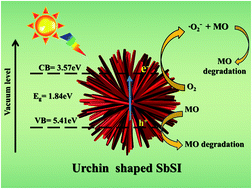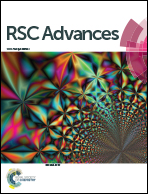Antimony sulphoiodide (SbSI), a narrow band-gap non-oxide ternary semiconductor with efficient photocatalytic activity†
Abstract
In the context of the harvesting of solar photons, one dimensional semiconductors are attractive as they provide uninterrupted transport pathways for charge carriers, along the covalently bonded atomic chain direction. Moreover, the one-dimensional growth leads to a lower proportion of dangling bonds at the surfaces due to preferential growth in a particular direction. We report here a non-metal oxide semiconductor, antimony sulphoiodide (SbSI) which displays high optical absorption and a low and tunable band gap for visible light photocatalytic applications. Highly crystalline 1-D micro-rods of SbSI which eventually self-assemble into 3-D “urchin”-shaped structures are synthesized by using a simple solution method. The morphology of the SbSI is studied in terms of the dangling bonds at the surface planes. The results conclusively show that the SbSI has a lower proportion of dangling bonds at the surface. The electronic structure of SbSI, studied using density functional theory, displays a large static dielectric constant due to the ns2 cation (Sb3+) which enhances the separation of electron and hole pairs effectively. The combination of these two features makes SbSI a promising material for visible photocatalytic degradation of organic pollutants in water, in spite of an overall low surface area (≈2.6 m2 g−1).


 Please wait while we load your content...
Please wait while we load your content...